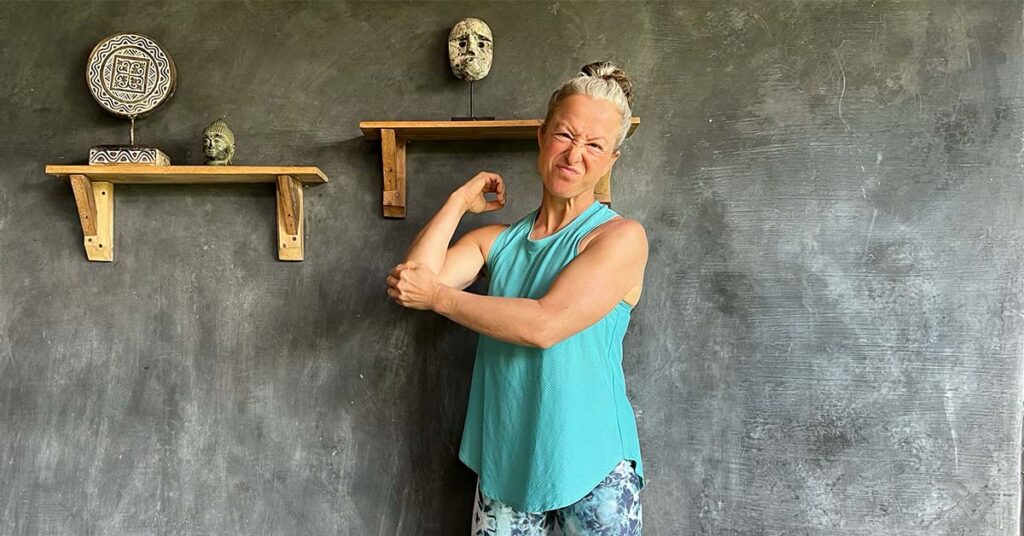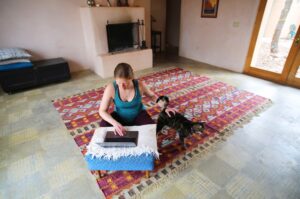If you feel like you’re glued to your keyboard these days, you’re not alone. Since COVID, so much of our life happens on our phones and computers. This can take a big toll on our bodies. Typing a lot can create really tight forearms, which sometimes leads to elbow pain like tennis elbow and golfer’s elbow.
I’ve been typing a lot recently, and I’ve noticed that my own arms have been a bit grumpy. So I thought I’d share some of my favourite mobility exercises to help loosen up tight forearms and banish elbow pain. Even if you don’t have elbow pain, these exercises can be really helpful if you’re noticing wrist or shoulder issues. That’s because overloaded, tight forearms have a big impact on the body parts that are close by!
Let’s start with a quick overview of exactly what’s going on with tightness and pain in our forearms and elbows. Then we’ll dive right into some great mobility exercises that have really helped me improve my tight forearms and eliminate my elbow pain.

How Tight Forearms Cause Elbow Pain
I first noticed elbow pain when we were renovating our house before our big trip. My job was doing all the painting. And it didn’t take too long before all the painting did a number on my right elbow. I’d given myself a case of tennis elbow without ever playing tennis!
This is typical, by the way. Most so-called ‘tennis elbow’ happens because of activities like typing, knitting, painting, doing construction or plumbing, and other repetitive activities where we use our forearms.
Since most of us type a lot, most of us have really tight, overloaded forearms these days, whether or not we’re painting a house. Modern life creates a lot of repetitive and unvaried loads for our hands and arms. And this is exactly what bodies don’t like.
Over time, our tight, overused forearm muscles start to stress our tendons, and that’s what causes the pain of tennis (or golfer’s) elbow. The stress begins as micro-tears and inflammation. If it’s not addressed, the tears get worse, the tendons degenerate and becomes less organized, and everything gets harder to fix.

How To Heal Elbow Pain
Ironically, the best way to treat elbow pain and forearm tightness is to move more. But we need to move in different ways – not just more of the same movements that hurt us in the first place.
Smart, careful movement helps rebuild tendons in an organized way and eventually will help all the muscle and tissues of the forearm become stronger and more resilient. All the tissues of the forearm run through the elbow joint in a natural, connected flow, so working specifically on the joint is a key area to target.
Even if you’re not experiencing forearm tightness or elbow pain, most of us benefit from doing some movement and mobility for our forearms. It’s great for all our cells and tissues to experience movement variety and most of us are a lot more gummed up in our forearms than we think!
Start Here: Healing Elbow Pain With CARs and Isometrics
If you’re currently in pain, you’ll want to be careful as you explore movement work. It’s so important to listen to your body here – go super lightly at first. Then if your body feels ready, you can start dialing up the intensity.
In this sequence, we’re going to do Controlled Articular Rotations (CARs) for the elbow, and also positional isometrics.
How CARs help forearm tightness and elbow pain
CARs help with healing in a number of ways. CARS improve our awareness of the elbow joints which helps improve how they move. They also strengthen tendons and other forearm tissues. Finally, CARs give our bodies signals to rebuild tendons in that nice, organized way. For healing, the best way to do CARs is very light (about 10% of your possible maximum effort) and frequently – many times a day!
How Positional Isometrics help forearm tightness and elbow pain
Positional Isometrics also help strengthen and reform the tissues of our forearms and elbow joints.
An isometric is where we contract our muscles without moving them. Because we don’t move during isometrics, they’re very safe. Plus isometrics have an analgesic effect. Doing them can actually decrease pain. Like CARs, do isometrics lightly at first (and frequently). As you get stronger, you can increase the intensity.
For best results, learn these exercises and do them daily and often until you notice improvements.
Next Steps: Mobilize Tight Forearms & Banish Elbow Pain
If you’re not currently in pain or if you’ve used CARs and isometrics to start your healing, you can take the next step. Here we’re going to start improving your tight forearms and elbow mobility.
Here we’re going to use CARs again, but this time as a warm up. That means we’ll do the CARs at a higher intensity to prepare the tissues for greater loads and more work. As always, moderate your intensity if anything doesn’t feel good.
Using PAILs and RAILS to improve elbow mobility and mobilize tight forearms
We’re also going to use PAILs and RAILs (Progressive Angular Isometric Loading and Regressive Angular Isometric Loading). These exercises are the gold standard in increasing the range of motion in our joints. By improving out joint range of motion, we decrease forearm tightness and elbow pain, and create improved mobility.
In most cases, the reason our range of motion is restricted is not actually because our tissues are too ‘short’. In fact, it’s because our nervous systems protect us by keeping our movement within the limited ranges where we typically move. That means we need to work with our nervous systems if we want to create a change in mobility.
By doing a PAILs contraction, we teach our nervous system to generate force in our end range of joint movement. This seems to make our brains feel safer in this end position. When we follow up by doing a RAILs contraction, we ask our nervous system to give us more movement in our joint. It often will, because we started with the PAILs. The result of PAILs and RAILs is that our bodies will give us an increased range of motion for a brief window of opportunity.
Because we’ve only addressed our nervous system with PAILs and RAILs, there’s still some work left to do. Once we finish doing PAILs and RAILs, it’s important to do a few more CARs or other similar movements to help consolidate our gains. This is what ‘saves our work’. It’s just like hitting the save button on a computer.
In this class, you’ll learn how to do elbow PAILs/RAILS for pronation. This is the direction that will help with tennis elbow pain as well as improving forearm mobility.

How to use this class to improve tight forearms long term
For best results in improving tight forearms, try doing this sequence 3-5x weekly for a few weeks or until you feel like you’ve decreased your forearm tightness.
You’ll need a chair to sit on and a sturdy dowel, ABS pipe or other stick-like thing for this class. Do not use a Swiffer! They aren’t strong enough. I recommend using something around 4 feet long if you can but longer works too if need be.
Enjoy!
How Do Your Forearms Feel Now?
I hope you enjoyed those classes as much as I enjoyed teaching them!
My forearms definitely have improved a ton since I started doing focused mobility work – even though I still type way too much! I have far less forearm tightness and almost no elbow pain. It would be better if I never typed at all, but that’s how modern life is. I love having great tools to support my wellness despite needing to be on a keyboard every day! For best results, it’s probably a really good idea to work on wrist and shoulder mobility as well. That’s because everything’s connected!
If you’re interested in more movement tips, sign up for my weekly newsletter!




